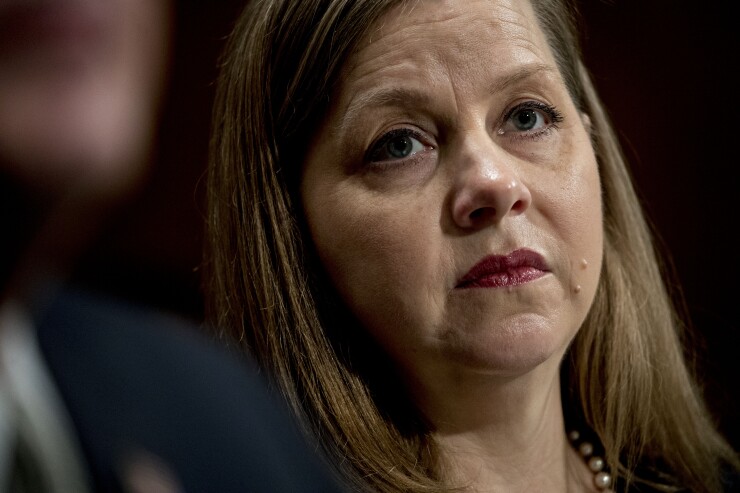
It has been a busy year for Michelle Bowman, the Federal Reserve Board's resident
The Fed governor has delivered close to
The cadence of Bowman's speeches have grown more frequent and more forceful throughout the year, spurred on by recent events. First, the
To Bowman, the changes fail to pass muster individually. They are unjustified, unnecessary and — in the case of the Community Reinvestment Act reforms
"While the unintended consequences of these reforms may not be clear at the outset, our ability to predict these consequences is even more limited when the reforms overlap or conflict," Bowman told attendees last week during the New York Bankers Association's Financial Services Forum in South Florida. "The sheer volume of change presents significant challenges for banks, who will be required to prioritize the implementation of new and revised requirements, with the risk of being distracted from more material concerns or supervisory issues."
Bowman has
In a written statement provided to American Banker, Bowman said her willingness to speak her mind and break from the rest of the board stems from her personal convictions about the optimal course of action for the Fed as a regulator. She also noted that sharing her views publicly is a way to advance the conversation around policy debates.
"My voting record has always been driven by my substantive views and concerns," Bowman said in a written statement provided to American Banker. "My colleagues and I do not always agree on the path of regulatory reform, but in my experience, we reach the best outcome when we share our perspectives and concerns, and try to reach a compromise. Our goals are the same — to promote a banking system that is safe and sound, and supports the financial stability of the United States."
The issue that has drawn the bulk of Bowman's commentary in recent months is the so-called Basel III endgame proposal — a joint rulemaking from the Fed, Federal Deposit Insurance Corp. and the Office of the Comptroller of the Currency, which would
She's also taken issue with proposed changes to resolution requirements for large banks as well as board guidance on matters such as third-party risk management and climate change. Some of her most pointed commentary has been on the
Bowman has gone so far as to say regulators might have exceeded their statutory limitations with their CRA overhaul.
"Congress alone has the power to modernize the CRA statute, including reflecting the variety of financial institutions that provide credit and financial services in their communities," she said in a speech last week. "In my view, some of the changes made by the agencies, including those that evaluate banks outside of their deposit-taking footprint, are likely beyond the scope of our authority under the statute."
Bowman's remarks have drawn plaudits from individuals in and around the banking sector who feel the industry's rights are being trampled by recent Fed regulatory and supervisory actions. Kenneth H. Thomas, president of Miami-based Community Development Fund Advisors, a firm that specializes in CRA-eligible investments, commended Bowman for her willingness to stand alone.
"The [Board of Governors] has long been considered a group-speak body, but dissenting voices on the board, especially when they are well documented and correct as is presently the case with [Bowman's] CRA final rule dissent, are not only welcome but necessary," Thomas said. "For example, if we had more dissenting views in early and mid-2021, before [Fed Chair] Jay Powell's historic 'transitory inflation' Fed misspeak, we would not be dealing with our current inflation or pending recession problem."
Even those who are not ideologically aligned with Bowman have cheered on her dissenting votes and remarks.
"It's incredibly healthy," Peter Conti-Brown, a financial historian and legal scholar at the University of Pennsylvania's Wharton School of Business. "I probably agree with Miki Bowman 20% of the time and disagree with her 80% of the time, but 100% of the time I support having a healthy conversation about complex policy issues."
As Fed Chair Jerome Powell often notes, the Federal Reserve Board is a "
There were multiple stretches during which split decisions were common at the Fed. During the chairmanships of G. William Miller and Paul Volcker, which spanned from 1978 to 1987, the Federal Open Market Committee — which steers the central bank's monetary policy — averaged more than one dissenting vote per meeting, according to
In recent years, diverging votes on the FOMC have become fewer and farther between. Only two dissenting votes have been cast on monetary policy adjustments during the past three years, and the committee has not seen more than two members break from the majority since September 2019.
Among Fed governors on the FOMC, opposition is even scarcer, as a member of the board has not voted against a policy decision since 2005. Since the mid-1990s, regional reserve bank presidents have accounted for all but a handful of the no votes cast on the committee.
Conti-Brown said there are practical reasons for Fed chairs to minimize dissent on monetary policy moves. Divided votes could leave the FOMC open to accusations of acting politically, an untenable outcome, he said, when the decision at hand could directly impact employment.
"I see the virtues of that approach, even if I think they are overstated," Conti-Brown said. "The Fed wants very much for every FOMC meeting to result in a clear decision that is separate from what is good for the incumbent politicians. There is always an election in America, so the FOMC wants its decisions to very much be viewed independently, to insulate it from accusations of partisan maneuvering."
Conti-Brown said the story is different for regulatory issues. Unlike monetary considerations, which are made in response to specific data inputs have a limited range of possible outcomes — raising rates, cutting them or leaving them alone — regulations are multifaceted and largely philosophical.
"We're not simply coming together as experts to design a rocket to send to Mars," he said. "We're looking at issues of profound uncertainty."
It is harder to measure how robust non-monetary debates have been at the Fed. Data on board votes — on actions such as rule proposals and finalizations, enforcement actions, bank orders and other matters — are not as readily available. The Fed's website does not have information on votes before 2012. The first five years on record saw no public dissenting votes cast, but things began to change in 2018, when Brainard took on the role of principled opposition.
From 2018 through 2020, Brainard cast 23 dissenting votes. Like Bowman, she also delivered dozens of speeches and focused her objections on statutory components of the Fed's regulatory agenda, which was steered at the time by then-Vice Chair for Supervision Randal Quarles.
In Brainard's case, her oppositional campaign seems to have held some sway over Fed policy. In a recent interview with Rob Blackwell for the
"I spent a lot of time on the tailoring regulation working with the people who had different views, and that tailoring regulation, although I think that it accomplished a lot, didn't do everything that I would have done had I been king of the world," Quarles said. "Part of that was a view of, 'I need to get votes on the board,' but part of it was also a view as to what my role was as the vice chair. I wasn't a politician. I wasn't a senator that could put in my view and say 'Vote for it or not.' We're non-elected people. And part of my job is to try to craft something that takes into account the full range of views."
Quarles said his efforts to address concerns raised by dissenters resulted in changes that upset banks and some of his Republican supporters, but he noted that some level of give-and-take is necessary to ensure rule changes are long-lasting. He added that he is concerned that current regulatory policy makers — including his successor, Vice Chair for Supervision Michael Barr — have not been as amenable to differing perspectives.
"What I understand is that isn't happening this time. It's more a, 'Look, here's the proposal. If you don't like it, vote no,'" Quarles said on the podcast. "And the consequence of that is going to be that if those proposals go forward, then when the pendulum swings back, and it will swing back when the Republicans are once again in charge."
During testimony in front of the Senate Banking Committee on Tuesday, Barr said he provided his fellow board members with ample time to review and weigh in on certain proposals, including the so-called Basel III endgame, which would change risk-weighted capital requirements for large banks.
"They had an extensive period of time," Barr testified. "I'll get you the exact number of days but it was many, many weeks."
Barr also said he values the collegial nature of the board and noted that the majority of the 50 or so "substantive" regulatory or supervisory matters that have come before the board have garnered "full consensus" support.
On the matter of the Basel III endgame, Barr said he would strive for a unanimous vote in favor of the final rule, but could make no guarantees.
"As with all rules, we try very hard to get to as close to full consensus [as we can']," he said. "I would like to get broad consensus, I don't know whether I'll get full consensus."







